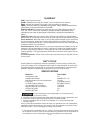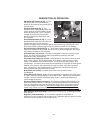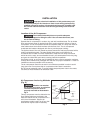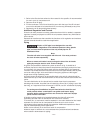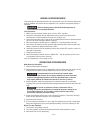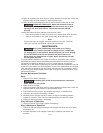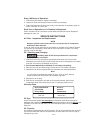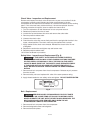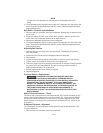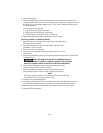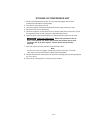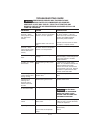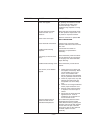
14-ENG
Unit cycles automatically when power is on. During
maintenance, you could be exposed to voltage sources, compressed
air, moving parts, or hot surfaces. Personal injuries can occur. Unplug
the unit and bleed off all air tank pressure and allow unit to cool
before doing any maintenance or repair. Never operate the unit with
the belt guard removed.
To ensure efficient operation and longer life of the air compressor unit, a routine
maintenance schedule should be prepared and followed. The following routine
maintenance schedule is geared to a unit in a normal working environment
operating on a daily basis. If necessary, the schedule should be modified to suit the
conditions under which your air compressor is used. The modifications will depend
upon the hours of operation and the working environment. Air compressor units in
an extremely dirty and/or hostile environment will require a greater frequency of all
maintenance checks.
Routine Maintenance Schedule
Daily:
1. Check oil level. Add if necessary.
Overfilling with oil will cause premature air compressor
pump failure. Do not overfill.
2. Open the shut-off valve.
3. Open the regulator and allow the air to slowly bleed from the air tank. Close the
regulator when air tank pressure is approximately 20 psi.
4. Drain water from the air tank, any moisture separators, or transformers.
5. Check for any unusual noise and/or vibration.
6. Manually check all safety valves to make sure they are operating properly.
7. Inspect for oil leaks. Take unit to an Authorized Service Center for repair.
8. Inspect air filter and replace if necessary.
Every 40 Hours of Operation:
1. Inspect condition of drive belt; replace if necessary.
Every 100 Hours of Operation:
1. Drain and refill compressor crankcase with 16 fluid ounces (473.2 ml) of clean
compressor oil.
2. Increase frequency of oil changes if humidity or operating conditions are
extreme.
MAINTENANCE
10.Open the regulator and allow the air to slowly bleed from the air tank. Close the
regulator when air tank pressure is approximately 20 psi.
11.Open the drain valve underneath the air tank and drain water from air tank.
DRAIN AIR TANK DAILY. Water will condense in the air
tank. If not drained, the water will corrode and weaken the air tank,
causing a risk of air tank rupture. The air tank must be drained
properly.
12.After the water has been drained, close the drain valve.
- if the air compressor is under continuous use, drain at least once each day.
- if the air compressor is only used occasionally, drain after each use.
Note
If drain cock valve is clogged, release air pressure in air tank. The drain
cock valve can then be removed, cleaned and reinstalled.



